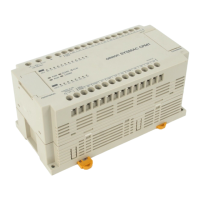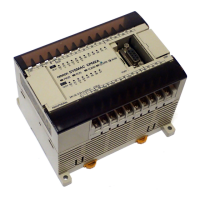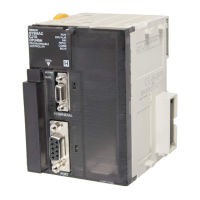6
Input/Output Requirements The first thing that must be assessed is the number of input and output points
that the controlled system will require. This is done by identifying each device
that is to send an input signal to the PC or which is to receive an output signal
from the PC. Keep in mind that the number of I/O points available depends on
the configuration of the PC.
Next, determine the sequence in which control operations are to occur and the
relative timing of the operations. Identify the physical relationships between the
I/O devices as well as the kinds of responses that should occur between them.
For instance, a photoelectric switch might be functionally tied to a motor by way
of a counter within the PC. When the PC receives an input from a start switch, it
could start the motor. The PC could then stop the motor when the counter has
received a specified number of input signals from the photoelectric switch.
Each of the related tasks must be similarly determined, from the beginning of the
control operation to the end.
Unit Requirements The actual Units that will be mounted or connected to PC Racks must be deter-
mined according to the requirements of the I/O devices. Actual hardware specifi-
cations, such as voltage and current levels, as well as functional considerations,
such as those that require Special I/O Units, CPU Bus Units, or Link Systems will
need to be considered. In many cases, Special I/O Units, CPU Bus Units or Link
Systems can greatly reduce the programming burden. Details on these Units
and Link Systems are available in appropriate
Operation Manuals
and
System
Manuals
.
Once the entire Control System has been designed, the task of programming,
debugging, and operation as described in the remaining sections of this manual
can begin.
1-6 PC Operating Modes
CV-series PCs have four operation modes: PROGRAM, DEBUG, MONITOR,
and RUN. The Unit will automatically enter the mode specified in the PC Setup
(default setting: PROGRAM mode). Refer to
Section 7 PC Setup
for details. The
PC mode can be changed from a Peripheral Device. The function of each mode
is described briefly below.
PROGRAM mode is used when making basic changes to the PC program or set-
tings, such as transferring, writing, changing, or checking the program, generat-
ing or changing the I/O table, or changing the PC Setup. The program cannot be
executed in PROGRAM mode. Output points at Output Units will remain OFF,
even when the corresponding output bit is ON.
DEBUG mode is used to check program execution and I/O operation after syn-
tax errors in the program have been corrected. With SFC programs, a single
step can be checked for errors from a Peripheral Device using the DEBUG op-
eration. Output points at Output Units will remain OFF, even when the corre-
sponding output bit is ON.
MONITOR mode is used when monitoring program execution, such as making a
trial run of a program. The program is executed just as it is in RUN mode, but bit
status, timer and counter SV/PV, and the data content of most words can be
changed online. PC operation in MONITOR mode is significantly slower than it is
in RUN mode. Output points at Output Units will be turned ON when the corre-
sponding output bit is ON.
RUN mode is used when operating the PC in normal control conditions. Bit sta-
tus cannot be Force Set or Reset, and SVs, PVs, and the data cannot be
changed online. Output points at Output Units will be turned ON when the corre-
sponding output bit is ON.
Sequence, Timing, and
Relationships
PROGRAM Mode
DEBUG Mode
MONITOR Mode
RUN Mode
PC Operating Modes Section 1-6

